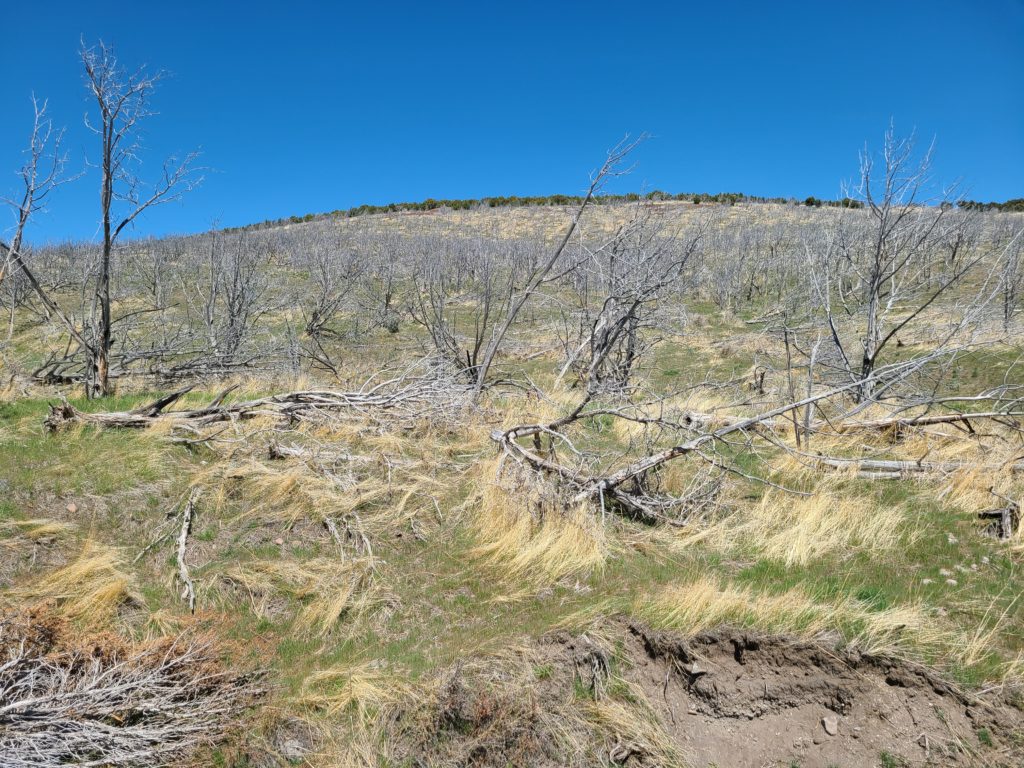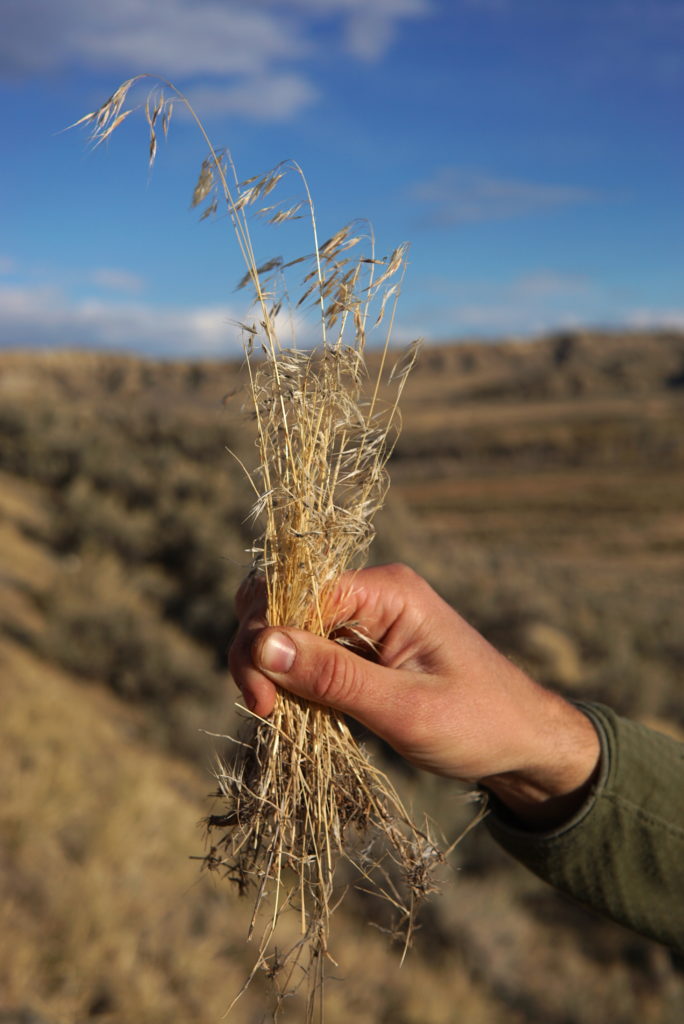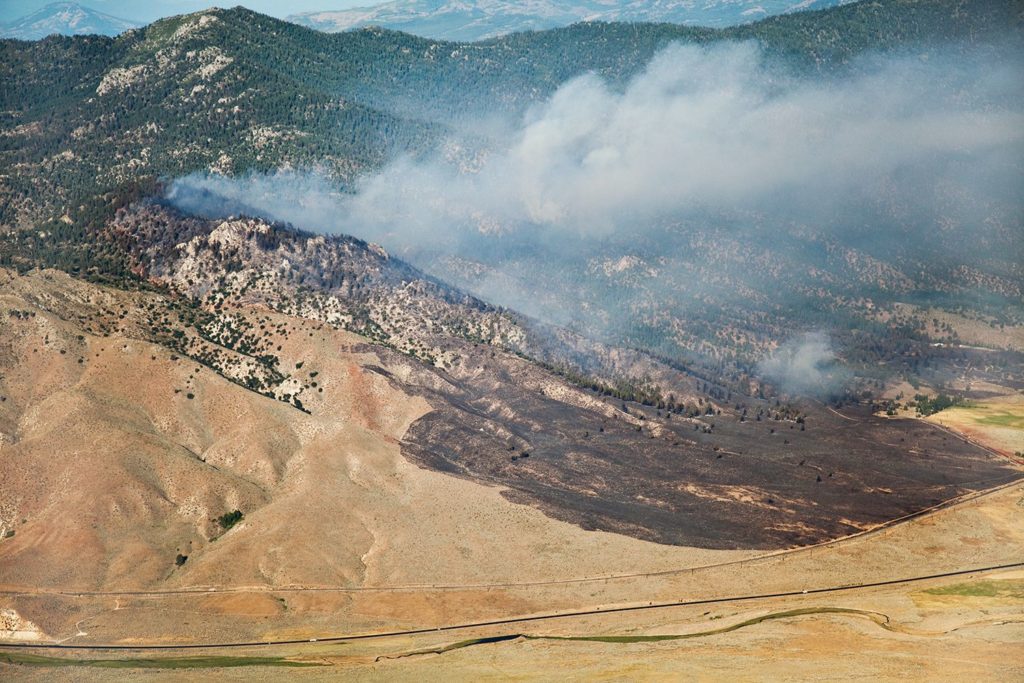Pinyon-Juniper Encroachment: Effects on Invasive Species

Key Points
- Invasive grass species emerge early in the growing season to easily outcompete native grasses and forbs and can take advantage of areas where these species have been lost.
- Invasive species produce fine fuels that dry out early, resulting in more flammable ecosystems that promote changes in fire behavior.
- Pinyon-juniper encroachment into sagebrush ecosystems increases fuel loads, reduces understory plants, and can result in shifts to annual grass dominance after fire.
- Management needs to be carefully planned in sagebrush ecosystems to avoid encouraging the spread of annual non-native grasses. Site characteristics are key in determining the probability of annual grass invasion.
What is pinyon-juniper encroachment?
Pinyon-juniper encroachment is the expansion of pinyon-juniper woodlands into ecosystems that historically were shrublands or grasslands. These tree species have increased in abundance due to fire suppression, land use and favorable climate. A significant portion of this encroachment occurs in sagebrush rangelands and affects many processes within these ecosystems.

The invasive annual grass problem
Annual non-native grasses are invading sagebrush ecosystems, which has implications for plant community dynamics and fire regimes. Grasses such as cheatgrass (Bromus tectorum), medusahead (Taeniatherum caput-medusae) and ventenata (Ventenata dubia) are overtaking these systems due to their ability to emerge early and respond quickly to available soil moisture. These annual grasses have a shorter growing season, so they become brown and dry early, creating a significant amount of continuous fine fuels during the summer that can increase the frequency of fire and overall area burned. A shorter growing season followed by fire reduces the amount of time for the slower growing native species to establish, allowing the fast-emerging invasive species to dominate the system. Additionally, annual grasses respond to conditions after many types of disturbance that alter vegetation and soil (e.g. fire, severe drought, landslides, land use, etc.), growing rapidly to outcompete native species. These altered fire and community dynamics can lead to a cycle of frequent fire fueled by an annual grass monoculture.
A dangerous combination
Exacerbating this problem is the encroachment of pinyon and juniper species into sagebrush communities. As trees establish in shrublands, herbaceous and shrub cover is greatly reduced under competition, where trees have a competitive advantage for resources such as water, nutrients and sunlight. This greater density of trees also increases the fuel load and the chance of high-severity fire. Fires in encroached sagebrush communities can result in significant loss of native species and increase the likelihood and magnitude of conversion to annual non-native grasses. Greater tree density reduces the amount of native perennial grasses and forbs to compete with invasive species in the understory, while increased fire severity, and thus mortality, offers an opening for annual grass invasion.
Not only does this conversion to woodland increase the likelihood of carbon emissions into the atmosphere as a larger part of the carbon pool is above ground and susceptible to fire, but it also reduces future carbon sequestration due to shallower soil carbon profiles of invading annual grasses over the native deep-rooted perennial plants. Establishment of annual grasses and subsequent increases in fire also affect soil properties, increase soil loss by erosion, and alter soil water availability. Additionally, annual grass invasion impacts forage for wildlife and livestock by lowering the quantity and quality of feed and shortening the grazing season.

Invasive species response to pinyon-juniper management
As invasive annual grasses are common across much of the sagebrush ecosystem, management of encroaching pinyon-juniper woodlands has the potential to intensify invasion if not planned properly. Nonnative grasses respond to disturbances from mechanical treatments and prescribed fire, which can increase availability of resources (e.g., water and nutrients). There are, however, ways to mitigate invasive species response to management, as risk of invasion depends on site conditions and existing vegetation before treatment. Using site characteristics, such as tree cover, soil temperatures and moisture regime, can help guide management and treatments to reduce invasion. Areas with depleted perennial grasses and forbs, often due to encroaching pinyon and juniper trees, are at higher risk of invasion than those with abundant perennial herbaceous plants. Additionally, warmer and drier sites are more susceptible to invasive species increases than cooler and moister areas. By combining thoughtful management that considers invasive species seed source and minimizes disturbance with native reseeding or herbicide application, non-native grass invasion can be greatly reduced years after treatment.

References
» Balch, J. K., Bradley, B. A., D’Antonio, C. M., & Gómez‐Dans, J. (2013). Introduced annual grass increases regional fire activity across the arid western USA (1980–2009). Global Change Biology, 19(1), 173–83.
» Brooks, M. L., D’Antonio, C. M., Richardson, D. M., Grace, J. B., Keeley, J. E., DiTomaso, J. M., Hobbs, R. J., Pellant, M., & Pyke, D. (2004). Effects of invasive alien plants on fire regimes. BioScience, 54(7), 677–88. Annual non-native grasses are invading sagebrush ecosystems. Photo by Hannah Nikonow. Pinyon-juniper encroachment combines with annual grass invasion for increased degradation of these ecosystems. Photo by Nolan Preece.
» Chambers, J. C., Bradley, B. A., Brown, C. S., D’Antonio, C., Germino, M. J., Grace, J. B., Hardegree, S. P., Miller, R. F., & Pyke, D. A. (2014). Resilience to stress and disturbance, and resistance to Bromus tectorum L. invasion in cold desert shrublands of western North America. Ecosystems, 17(2), 360–75.
» Condon, L., Weisberg, P.J., & Chambers J.C. (2011). Abiotic and biotic influences on Bromus tectorum invasion and Artemisia tridentata recovery after fire. International Journal of Wildland Fire, 20, 597–604.
» Jobbagy, E.G., & Jackson, R.B. (2000). The vertical distribution of soil organic carbon and its relation to climate and vegetation. Ecological Applications, 10, 423–436.
» Kyser, G. B., Wilson, R. G, Zhang, J., & DiTomaso, J. M. (2013). Herbicide-assisted restoration of Great Basin sagebrush steppe infested with medusahead and downy brome. Rangeland Ecology & Management, 66(5), 588–96.
» Miller, R.F., & Tausch, R.J. (2001). The role of fire in juniper and pinyon woodlands a descriptive analysis. K.E.M. Galley, T. Wilson (Eds.), Proceedings of the Invasive Species Workshop: The Role of Fire in The Control and Spread of Invasive Species, Tall Timbers Research Station Miscellaneous Publication Number 11, Tallahassee, FL, p. 15-30.
» Miller, R. F., Chambers, J. C., & Pellant, M. (2014). A field guide for selecting the most appropriate treatment in sagebrush and pinon-juniper ecosystems in the Great Basin: Evaluating resilience to disturbance and resistance to invasive annual grasses, and predicting vegetation response. Gen. Tech. Rep. RMRS-GTR-322-rev. Fort Collins, CO: U.S. Department of Agriculture, Forest Service, Rocky Mountain Research Station. 66 p.
» Miller, R. F., Chambers, J. C., & Pellant, M. (2015). A field guide for rapid assessment of post-wildfire recovery potential in sagebrush and pinonjuniper ecosystems in the Great Basin: Evaluating resilience to disturbance and resistance to invasive annual grasses and predicting vegetation response. Gen. Tech. Rep. RMRS-GTR-338. Fort Collins, CO: U.S. Department of Agriculture, Forest Service, Rocky Mountain Research Station. 70 p.
» Rau, B. M., Johnson, D.W., Blank, R.R., & Chambers, J. C. (2009). Soil carbon and nitrogen in a Great Basin pinyon-juniper woodland: influence of vegetation, burning, and time. Journal of Arid Environments, 73, 472–479.
» Rau, B. M., Johnson, D. W., Blank, R. R., Lucchesi, A., Caldwell, T. G., & Schupp, E. W. (2011). Transition from sagebrush steppe to annual grass (Bromus tectorum): influence on belowground carbon and nitrogen. Rangeland Ecology and Management, 64(2), 139–147.
» Roundy, B.A., Miller, R.F., Tausch, R.J., Young, K., Hulet, A., Rau, B., Jessop, B., Chambers, J. C., & Eggett. D. (2014). Understory cover responses to piñon–juniper treatments across tree dominance gradients in the Great Basin. Rangeland Ecology and Management. 67(5), 482-494.
» Roundy, B. A., Chambers, J.C., Pyke, D.A., Miller, R.F., Tausch, R.J., Schupp, E.W. Rau, B., & Gruell, T. (2018). Resilience and resistance in sagebrush ecosystems are associated with seasonal soil temperature and water availability. Ecosphere, 9, e02417.
» Strand, E. K., Vierling, L. A., Smith, A. M. S., & Bunting, S. C. (2008). Net changes in aboveground woody carbon stock in western juniper woodlands, 1946–1998. Journal of Geophysical Research: Biogeosciences, 113(G1). » Urza, A. K., Weisberg, P. J., Chambers, J. C., Board, D., & Flake, S. W. (2019). Seeding native species increases resistance to annual grass invasion following prescribed burning of semiarid woodlands. Biological Invasions, 21, 1993-2007.
» Verdu, M., & Traveset, A. (2005). Early emergence enhances plant fitness: a phylogenetically controlled meta-analysis. Ecology, 86, 1385-1394. » D’Antonio, C. M., & Vitousek, P. M. (1992). Biological invasions by exotic grasses, the grass/fire cycle, and global change. Annual Review of Ecology and Systematics, 23(1), 63–87.
» Weltz, M. A., Spaeth, K., Taylor, M.H., Rollins, K., Pierson, F., Jolley, L., Nearing, M., Goodrich, D. Hernandez, M., Nouwakpo, S. K., & Rossi, C. (2014). Cheatgrass invasion and woody species encroachment in the Great Basin: benefits of conservation. Journal of Soil and Water Conservation, 69, 39–44.
» Wilcox, B.P. , Turnbull, L., Young, M.H., Williams, J., Ravi, S., Seyfried, M.S., Bowling, D.R., Scott, R.S., Germino, M., Caldwell, T., & Wainwright, J. (2012). Invasion of shrublands by exotic grasses: ecohydrological consequences in cold versus warm deserts. Ecohydrology, 5(2), 160-173.
» Williams, R. E., Roundy, B. A., Hulet, A., Miller, R. F., Tausch, R. J., Chambers, J. C., Matthews, J., Schooley, R., & Eggett, D. (2017). Pretreatment tree dominance and conifer removal treatments affect plant succession in sagebrush communities. Rangeland Ecology and Management, 70, 759–773.